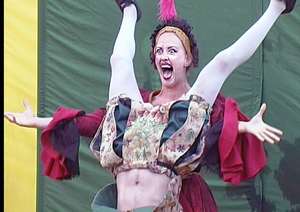One convention in Commedia dell’Arte is to take of the mask in the middle of the play explaining that a mistake has been made and he will now be repeating the gag or trick or blaming the director/author when a gag didn’t work.
And theatre is no need for an actor who is not on stage to run and hide from the audience. They can very well take of their masks and go and sit in the audience or even better pass the hat. Changing clothes and so on may be done in front of the audience. No one would believe that there would be someone else under the mask anyway. We all know that is just theatre the whole time.
Sometimes, especially when playing indoors, it may be an idea not to show these things, since modern audiences are not used to it. The risk is that is takes too much of the audience’s attention.
When I tell about my little walk in the forest (see PART 1) I keep eye contact with the audience. I can even ask questions to the audience, that they are answering. I am in dialog with the audience, without losing the illusion of the walk in the forest. In the same way is the audience in Commedia dell’Arte always a present, active and important part of the show. It is therefore very essential to see and listen to the audience the whole time. We must actively incorporate the audience in the show by listen to them and react to every little detail they say or do. It is in fact much more important to listen to the audience that to our fellow masks. In that way we are inviting the audience into the show.


Pingback: No 4:th wall in Commedia dell’Arte (Part 1) |